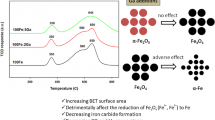Abstract
Zn, K, and Cu effects on the structure and surface area and on the reduction, carburization, and catalytic behavior of Fe–Zn and Fe oxides used as precursors to Fischer–Tropsch synthesis (FTS) catalysts, were examined using X-ray diffraction, kinetic studies of their reactions with H2 or CO, and FTS reaction rate measurements. Fe2O3 precursors initially reduce to Fe3O4 and then to metallic Fe (in H2) or to a mixture of Fe2.5C and Fe3C (in CO). Zn, present as ZnFe2O4, increases the surface area of precipitated oxide precursors by inhibiting sintering during thermal treatment and during activation in H2/CO reactant mixtures, leading to higher FTS rates than on ZnO-free precursors. ZnFe2O4 species do not reduce to active FTS structures, but lead instead to the loss of active components; as a result, maximum FTS rates are achieved at intermediate Zn/Fe atomic ratios. Cu increases the rate of Fe2O3 reduction to Fe3O4 by providing H2 dissociation sites. Potassium increases CO activation rates and increases the rate of carburization of Fe3O4. In this manner, Cu and K promote the nucleation of oxygen-deficient FeO x species involved as intermediate inorganic structures in reduction and carburization of Fe2O3 and decrease the ultimate size of the Fe oxide and carbide structures formed during activation in synthesis gas. As a result, Cu and K increase FTS rates on catalysts formed from Fe–Zn oxide precursors. Cu increases CH4 and the paraffin content in FTS products, but the additional presence of K inhibits these effects. Potassium titrates residual acid and hydrogenation sites and increases the olefin content and molecular weight of FTS products. K increases the rate of secondary water–gas shift reactions, while Cu increases the relative rate of oxygen removal as CO2 instead of water after CO is dissociated in FTS elementary steps. Through these two different mechanisms, K and Cu both increase CO2 selectivities during FTS reactions on catalysts based on Fe–Zn oxide precursors.
Similar content being viewed by others
References
F. Fischer and H. Tropsch, Brennstoff-Chem. 7 (1926) 97.
R.B. Anderson, in: Catalysis, Vol. 4, ed. P.H. Emmett (Van Nostrand-Reinhold, New York, 1956) p. 29.
H.H. Storch, N. Golumbic and R.B. Anderson, The Fischer-Tropsch and Related Syntheses (Wiley, New York, 1951)
R.B. Anderson, The Fischer-Tropsch Synthesis (Wiley, New York, 1984).
M.E. Dry, The Fischer-Tropsch Synthesis, Catal. Sci. Technol., Vol. 1, eds. J.R. Anderson and M. Boudart (Springer, New York, 1981) p. 160.
H. Kolbel and M. Ralek, Catal. Rev. Sci. Eng. 21 (1980) 225.
J.W. Niemantsverdriet and A.M. van der Kraan, J. Catal. 72 (1981) 385.
J.A. Amelse, J.B. Butt and L.J. Schwartz, J. Phys. Chem. 82 (1978) 558.
G.B. Raupp and W.N. Delgass, J. Catal. 58 (1979) 348.
R. Dictor and A.T. Bell, J. Catal. 97 (1986) 121.
J.P. Reymond, P. Meriaudeau and S.J. Teichner, J. Catal. 75 (1982) 39.
S. Kuivila, P.C. Stair and J.B. Butt, J. Catal. 118 (1989) 299.
S. Huang, L. Xu and B.H. Davis, Fuel Sci. Techol. Int. 11 (1993) 639.
E. Iglesia, S.C. Reyes, R.J. Madon and S.L. Soled, Adv. Catal. 39 (1993) 221.
S. Soled, E. Iglesia, S. Miseo, B.A. DeRites and R.A. Fiato, Topics Catal. 2 (1995) 193.
S. Soled, E. Iglesia and R.A. Fiato, Catal. Lett. 7 (1990) 271.
A.P. Raje, R.J. O'Brien and B.H. Davis, J. Catal. 180 (1998) 36.
S. Li, S. Krishnamoorthy, A. Li, G.D. Meitzner and E. Iglesia, J. Catal., submitted.
R.J. O'Brien, L. Xu, R.L. Spicer, S. Bao, D.R. Milburn and B.H. Davis, Catal. Today 36 (1997) 325.
S. Li, G.D. Meitzner and E. Iglesia, J. Phys. Chem. B, in press.
S. Li, G.D. Meitzner and E. Iglesia, J. Phys. Chem. B, submitted.
D.R. Lide and H.P.R. Frederikse, eds.; Handbook of Chemistry and Physics, 75th Ed. (The Chemical Rubber Company Press, Boca Raton, 1994).
S. Li, G.D. Meitzner and E. Iglesia, unpublished results.
M.J. Tiernan, P.A. Barnes and G.M.B. Parkes, J. Phys. Chem. B 105 (2001) 220.
H.H. Kung, Transitional Metal Oxides, Stud. Surf. Sci. Catal. 49 (1989).
G.A. Somorjai, Catal. Rev. Sci. Eng. 23 (1981) 189.
R. Habermehl and K. Atwood, Am. Chem. Soc. Div. Fuel. Chem. Prepr. 8 (1964) 10.
Author information
Authors and Affiliations
Rights and permissions
About this article
Cite this article
Li, S., Li, A., Krishnamoorthy, S. et al. Effects of Zn, Cu, and K Promoters on the Structure and on the Reduction, Carburization, and Catalytic Behavior of Iron-Based Fischer–Tropsch Synthesis Catalysts. Catalysis Letters 77, 197–205 (2001). https://doi.org/10.1023/A:1013284217689
Issue Date:
DOI: https://doi.org/10.1023/A:1013284217689




